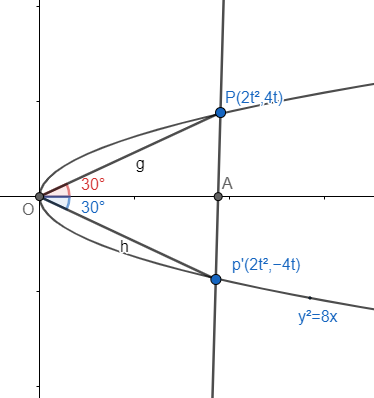
The length of double ordinate of parabola \[{{y}^{2}}=8x\] which subtends an angle \[{{60}^{\circ }}\] at vertex in
(a) \[4\sqrt{3}\]
(b) \[8\sqrt{3}\]
(c) \[16\sqrt{3}\]
(d) \[324\sqrt{3}\]
Answer
509.1k+ views
Hint: Draw figure of parabola \[{{y}^{2}}=8x\]. Consider the point on parabola as\[(a{{t}^{2}},2at)\]. Thus first the value of a and t, thus from the points of parabola and find the length of double ordinate.
Complete step-by-step answer:
We have been given the equation of parabola as\[{{y}^{2}}=8x\]. We know that the general representation of a parabola is\[{{y}^{2}}=4ax\]. Where 4a is latus rectum. By comparing both general equation and the given equation of parabola, we can say that
\[4a=8\]
\[\therefore \,\,\,a=\dfrac{8}{4}=2\]
We know that the point of parabola is \[(a{{t}^{2}},2at)\], put \[a=2\]. Thus we can make out the ordinate of parabola as \[(2{{t}^{2}},4t)\]. Let this be point P.
Thus the end points of double ordinate of parabola \[{{y}^{2}}=8x\] are P\[(2{{t}^{2}},4t)\] and \[P'(2{{t}^{2}},-4t)\].
Check the figure.

It is given that the double ordinate is subtended at an angle \[{{60}^{\circ }}\].
This angle \[{{60}^{\circ }}\]is bisected by the axis of the parabola.
Thus taking \[\tan {{30}^{\circ }}\]we get
\[\tan {{30}^{\circ }}=\dfrac{\text{Opposite side}}{\text{adjacent side}}=\dfrac{\text{AP}}{\text{OA}}\]
\[\tan {{30}^{\circ }}=\dfrac{\text{4t}}{\text{2}{{\text{t}}^{\text{2}}}}\]
From trigonometric table, we know that
\[\tan {{30}^{\circ }}=\dfrac{1}{\sqrt{3}}\]
\[\therefore \dfrac{1}{\sqrt{3}}=\dfrac{\text{2}}{\text{t}}\Rightarrow \text{t}=2\sqrt{3}\]
\[\therefore \]Point P\[(2{{t}^{2}},4t)\]becomes
\[\begin{align}
& P(2\times {{(2\sqrt{3})}^{2}},4\times 2\sqrt{3} \\
& =P(24,8\sqrt{3}) \\
\end{align}\]
Similarly point \[P'(2{{t}^{2}},-4t)\]becomes \[P'(24,8\sqrt{3})\]
\[\therefore \] We got the point as \[P(24,8\sqrt{3})\]and \[P'(24,8\sqrt{3})\].
What we need is the length of the double ordinate, we need to find PP’.
We can find it using the distance formula,
\[\begin{align}
& \sqrt{{{({{x}_{2}}-{{x}_{1}})}^{2}}+{{({{y}_{2}}-{{y}_{1}})}^{2}}}=\text{distance formula} \\
& ({{x}_{1}},{{y}_{1}})=(24,8\sqrt{3)} \\
& ({{x}_{2}},{{y}_{2}})=(24,-8\sqrt{3)} \\
\end{align}\]
\[\therefore \text{length of PP }\!\!'\!\!\text{ = }\sqrt{(24-24)+{{\left[ \left( 8\sqrt{3} \right)-\left( -8\sqrt{3} \right) \right]}^{2}}}\]
\[\begin{align}
& =\sqrt{0+{{\left( 8\sqrt{3}+8\sqrt{3} \right)}^{2}}} \\
& =\sqrt{{{\left( 16\sqrt{3} \right)}^{2}}} \\
& =16\sqrt{3} \\
\end{align}\]
Thus we got the length of the double ordinate as \[16\sqrt{3}\].
\[\therefore \]Option (c) is the correct answer.
Note: The double ordinate of parabola is any chord which is perpendicular to the axis of parabola. Here PA and P’A are the two chords which are perpendicular to the axis of the parabola, that’s why it is called a double ordinate.
Complete step-by-step answer:
We have been given the equation of parabola as\[{{y}^{2}}=8x\]. We know that the general representation of a parabola is\[{{y}^{2}}=4ax\]. Where 4a is latus rectum. By comparing both general equation and the given equation of parabola, we can say that
\[4a=8\]
\[\therefore \,\,\,a=\dfrac{8}{4}=2\]
We know that the point of parabola is \[(a{{t}^{2}},2at)\], put \[a=2\]. Thus we can make out the ordinate of parabola as \[(2{{t}^{2}},4t)\]. Let this be point P.
Thus the end points of double ordinate of parabola \[{{y}^{2}}=8x\] are P\[(2{{t}^{2}},4t)\] and \[P'(2{{t}^{2}},-4t)\].
Check the figure.

It is given that the double ordinate is subtended at an angle \[{{60}^{\circ }}\].
This angle \[{{60}^{\circ }}\]is bisected by the axis of the parabola.
Thus taking \[\tan {{30}^{\circ }}\]we get
\[\tan {{30}^{\circ }}=\dfrac{\text{Opposite side}}{\text{adjacent side}}=\dfrac{\text{AP}}{\text{OA}}\]
\[\tan {{30}^{\circ }}=\dfrac{\text{4t}}{\text{2}{{\text{t}}^{\text{2}}}}\]
From trigonometric table, we know that
\[\tan {{30}^{\circ }}=\dfrac{1}{\sqrt{3}}\]
\[\therefore \dfrac{1}{\sqrt{3}}=\dfrac{\text{2}}{\text{t}}\Rightarrow \text{t}=2\sqrt{3}\]
\[\therefore \]Point P\[(2{{t}^{2}},4t)\]becomes
\[\begin{align}
& P(2\times {{(2\sqrt{3})}^{2}},4\times 2\sqrt{3} \\
& =P(24,8\sqrt{3}) \\
\end{align}\]
Similarly point \[P'(2{{t}^{2}},-4t)\]becomes \[P'(24,8\sqrt{3})\]
\[\therefore \] We got the point as \[P(24,8\sqrt{3})\]and \[P'(24,8\sqrt{3})\].
What we need is the length of the double ordinate, we need to find PP’.
We can find it using the distance formula,
\[\begin{align}
& \sqrt{{{({{x}_{2}}-{{x}_{1}})}^{2}}+{{({{y}_{2}}-{{y}_{1}})}^{2}}}=\text{distance formula} \\
& ({{x}_{1}},{{y}_{1}})=(24,8\sqrt{3)} \\
& ({{x}_{2}},{{y}_{2}})=(24,-8\sqrt{3)} \\
\end{align}\]
\[\therefore \text{length of PP }\!\!'\!\!\text{ = }\sqrt{(24-24)+{{\left[ \left( 8\sqrt{3} \right)-\left( -8\sqrt{3} \right) \right]}^{2}}}\]
\[\begin{align}
& =\sqrt{0+{{\left( 8\sqrt{3}+8\sqrt{3} \right)}^{2}}} \\
& =\sqrt{{{\left( 16\sqrt{3} \right)}^{2}}} \\
& =16\sqrt{3} \\
\end{align}\]
Thus we got the length of the double ordinate as \[16\sqrt{3}\].
\[\therefore \]Option (c) is the correct answer.
Note: The double ordinate of parabola is any chord which is perpendicular to the axis of parabola. Here PA and P’A are the two chords which are perpendicular to the axis of the parabola, that’s why it is called a double ordinate.
Recently Updated Pages
Master Class 11 Economics: Engaging Questions & Answers for Success

Master Class 11 Business Studies: Engaging Questions & Answers for Success

Master Class 11 Accountancy: Engaging Questions & Answers for Success

The correct geometry and hybridization for XeF4 are class 11 chemistry CBSE

Water softening by Clarks process uses ACalcium bicarbonate class 11 chemistry CBSE

With reference to graphite and diamond which of the class 11 chemistry CBSE

Trending doubts
10 examples of friction in our daily life

Difference Between Prokaryotic Cells and Eukaryotic Cells

One Metric ton is equal to kg A 10000 B 1000 C 100 class 11 physics CBSE

State and prove Bernoullis theorem class 11 physics CBSE

State the laws of reflection of light

Write down 5 differences between Ntype and Ptype s class 11 physics CBSE




